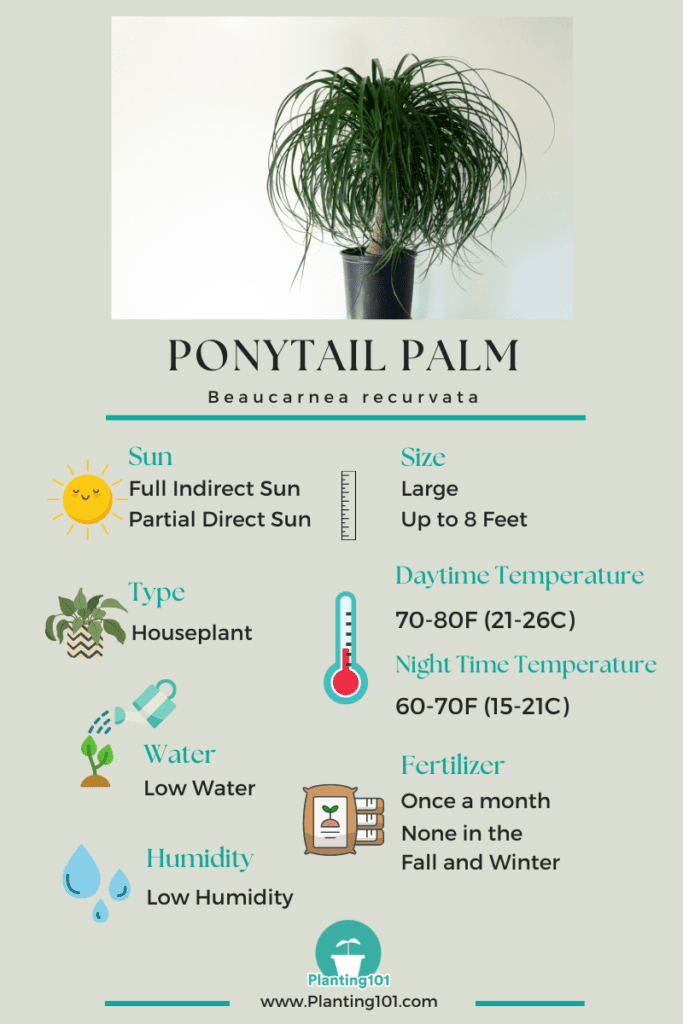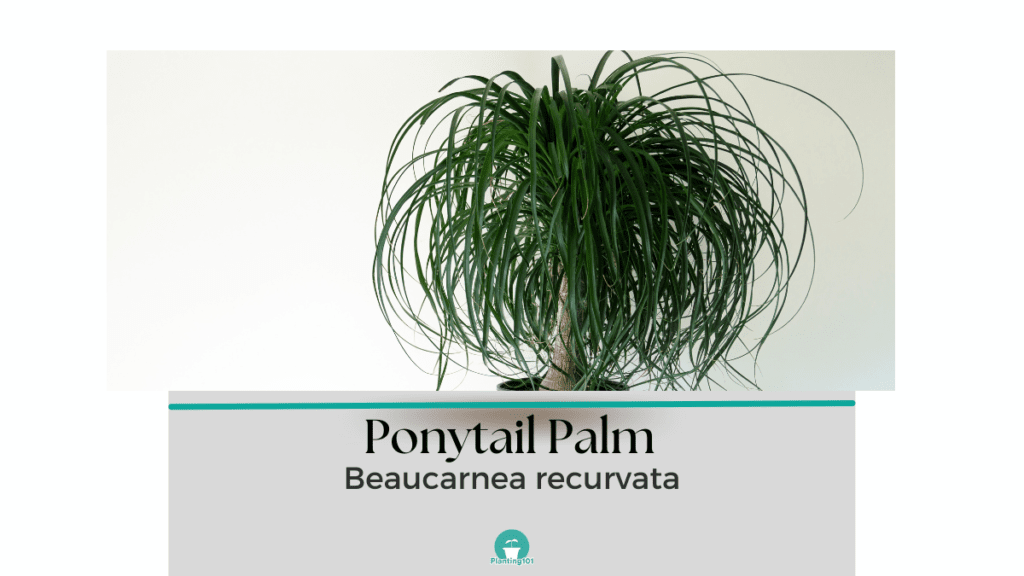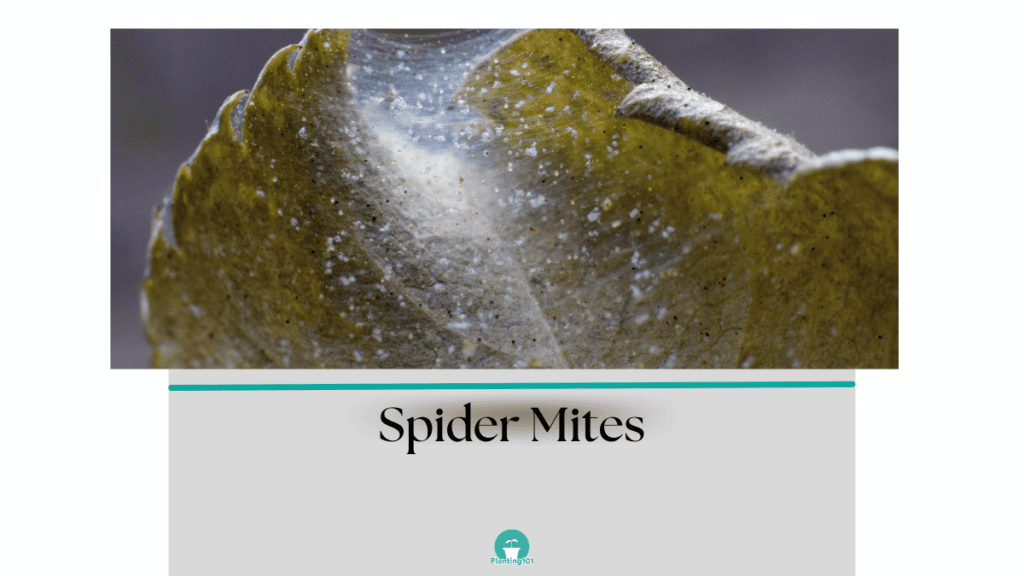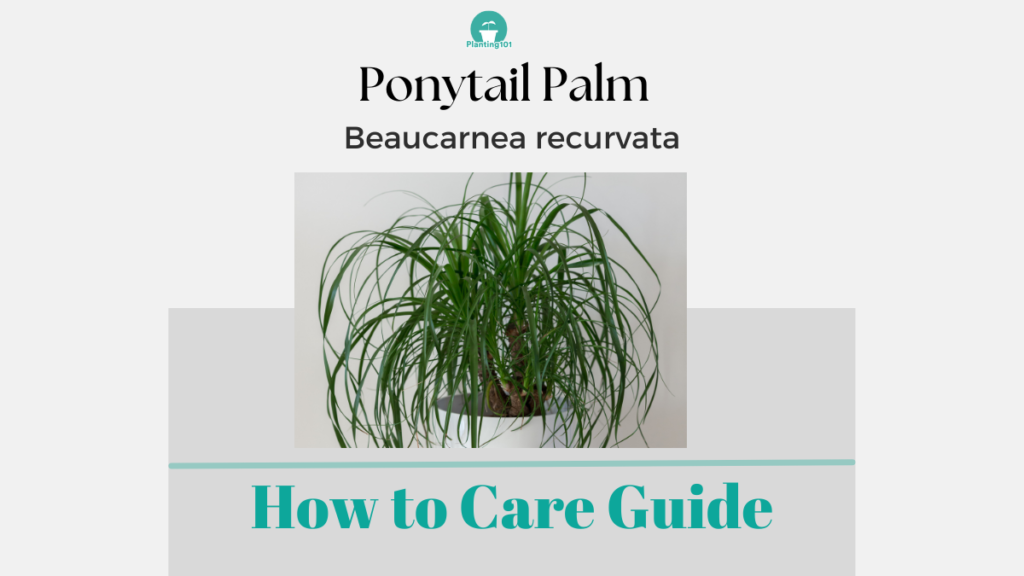Ponytail palm (Beaucarnea recurvata) are large plants beloved worldwide for its lush, cascading leaves. It makes a hardy indoor plant that is semi-succulent and drought tolerant. Ponytail Palm is sun loving and will thrive in full indirect sunlight. If you are looking for a large, low maintenance houseplant that does not need to be watered everyday, Ponytail Palm is ideal for you. In fact, it thrives in dry conditions and will only need occasional watering.
Here are tips and advice on how to take care of your Ponytail Palm.
Ponytail Palm Infograph

Ponytail Palm Characteristics
| Name | Ponytail Palm |
| Scientific Name | Beaucarnea recurvata |
| Light | Full Indirect Sun to Partial direct sun |
| Daytime Temperature | 70 to 80 F (21-26C) |
| Night Time Temperature | 60 to 70 F (15-21C) |
| Water | Low Water |
| Humidity | Low Humidity |
| Potting | Fast draining potting soil (cactus soil or succulent soil) |
| Fertilizer | Once a month but not in the Fall or Winter |
Do Ponytail Palm Prefer Sun or Shade?
Ponytail Palm is a sun loving indoor houseplant. The best placement for your Ponytail Palm is next to a south facing window. If you don’t have a south facing window, you can position your Ponytail Palm next to a west facing window with medium light. It will thrive happily in the afternoon sun.
How Often Should You Water Your Ponytail Palm?
Ponytail Palm prefers dry soil. Overly wet soil will kill it. Treat it like a semi-succulent, water only when the soil feels dry. During winter, water your Ponytail Palm sparingly.
How Do You Know When to Water Your Ponytail Palm?
Ponytail Palm does not need a lot of water, it’s a drought resistant, semi-succulent plant. The best way to tell when it’s time to water is by sticking your finger into the soil 2 inches down. If the soil feels dry, then water moderately. If the soil still feels moist and wet, don’t water it yet. Wait another week. When in doubt, it’s better to water less than to water too much.
What Type of Water Should You Use When Watering Your Ponytail Palm?
Ponytail Palm can be watered with tap water but be mindful of the water temperature that you are using to water your Ponytail Palm. Don’t use straight cold water from the tap to water your Ponytail Palm.
Ponytail Palm prefers cool water that is not hot and not cold. When you turn on the cold water from the faucet add a little bit of warm water. You can also get to this ideal temperature by filling a watering can or pitcher with water and leaving it out overnight until the water is at room temperature.
How Do You Make Sure There is Proper Drainage for Your Ponytail Palm?
Ponytail Palm needs proper drainage otherwise it might suffer from stem rot. To ensure proper drainage, make sure the pot has drainage holes at the bottom. After watering your plant, don’t let it sit in the puddle of water that has accumulated in the saucer. Empty out the water from the saucer.
Do You Need to Mist Your Ponytail Palm?
Ponytail Palm prefers low humidity so it’s not necessary to mist it.
What Type of Potting Mix is Best for Your Ponytail Palm?
Ponytail Palm needs a fast draining potting mix. You can buy premixed potting soil with mycorrhizal fungi that are made specially for cactus and succulents. It’s best to buy organic soil mixtures because non-organic soil mixtures often contain a higher concentration of fertilizer which can burn the roots of your plant. Non-organic soil mixtures are not generally suitable for houseplants.
Ponytail Palm Potting Mix
You can make your own potting mix for your Ponytail Palm by blending the following potting media:
- 1 part Horticultural Sand
- 1 Part General Purpose Organic Potting Medium
- 1 Part Perlite
Do You Need to Fertilize Your Ponytail Palm?
Ponytail Palm will benefit from a once a month application of fertilizer. Don’t feed in the Fall and Winter months when it’s dormant and not growing. Only fertilize your Ponytail Palm when it’s actively growing.
What Fertilizer Should You Use for Your Ponytail Palm?
Use organic fertilizer with a higher ratio of nitrogen. You can use fertilizers that are in powder or liquid form.
How Do You Know When To Repot Your Ponytail Palm?
It’s time to repot Ponytail Palm when the base trunk has grown to within 2 inches from the edge of the pot. That means it is outgrowing its current pot. Buy a larger pot, around 4 inches larger in diameter than the current pot. You will probably have to repot your Ponytail Palm every 2 to 3 years. Make sure you buy a pot that has drainage holes at the bottom so water doesn’t accumulate and cause root rot and stem rot.

How Big Do Ponytail Palm Houseplants Get?
Ponytail Palm can grow to 8 feet tall. Although, typically it gets to around 4 feet tall depending on the pot size. Ponytail Palm is a heavy plant though so it will be difficult to move around once it gets large. You may want to plant it in a pot with casters or wheels.
How Do You Propagate Ponytail Palm Houseplants?
Ponytail Palm is propagated by seed. However, when planted as an indoor houseplant, it will not bloom and produce seeds.
Are Ponytail Palm Houseplants Toxic to Pets?
Ponytail Palms are not toxic to pets but cats like to snack on the leaves so it’s best to keep the leaves out of reach.
What are Common Problems that Affects Your Ponytail Palm?
The common problems that affect Ponytail Palm are spider mites, stem rot and brown tips on leaves.
Why Did the Stem of Your Ponytail Palm Turn Brown and Mushy?
When the stem of your Ponytail Palm turns brown and mushy, this could be a sign of stem rot. Stem rot is caused by fungus and is a serious problem for your Ponytail Palm. The cause of stem rot is a result of wet soil due to overwatering or poor drainage. Fungus thrives in the wet soil and the spores are distributed in the water.
When your Ponytail Palm is afflicted with stem rot, it can be incurable. You can try to save your plant by removing the infected parts of the plant. Move the plant out of the potting soil and throw away the old soil. Replant it in a new pot in new soil. Make sure you sterilize the tools that you use so you don’t contaminate the new pot and potting mix.
The chances of plant survival is slim once your plant is afflicted with stem rot. Prevention is key, don’t overwater your Ponytail Palm in the first place and make sure there is good drainage in the pot.
Why Did the Tips of Leaves of Your Ponytail Palm Turn Brown?
The tips of the leaves of your Ponytail Palm turning brown are a result of low humidity or not enough watering. Check the soil moisture level by sticking your finger in a few inches to see if it is dry. If the soil is dry, then water your plant.
It’s also possible the pot is too small for your Ponytail Palm that is why it is not getting enough water. It may be time to repot your plant to a bigger pot.
If low humidity is the problem, you can mist the plant leaves. The room may also be dry, you can run a humidifier in the room.
Also make sure your plant is not right next to hot air from the HVAC vent, that can overtime kill your Ponytail Palm.
Once your Ponytail Palm receives adequate humidity and water, the leaves will start to look healthy and green again. Cut off the leaf tips that have already turned brown since the brown tips will not turn green again.
Why are There Yellow and Brown Spots on your Ponytail Palm Leaves and There are Webbing on Leaves and Stems?
These are signs of spider mites attacking your Ponytail Palm. It starts with yellow and brown spots on leaves and then eventually the entire leaf can even turn yellow and fall off the plant. You will also start to see spider web-like webbing covering the leaves and stems. These are telltale signs of spider mite infestation.
To treat spider mites on Ponytail Palm, you can spray off the leaves with water from a garden hose. The force will cause the little spider mites to wash off the leaves. You can also wash mites off with soapy water or rubbing alcohol. There are also horticultural oils and insecticidal soaps that you can use to kill off spider mites.
Check out our article on how to make your own homemade pesticides using baby shampoo: How to Make Horticultural Oil and How to Make Insecticidal Soap

You May Also Be Interested In:
How to Take Care of Haworthia (infograph)

